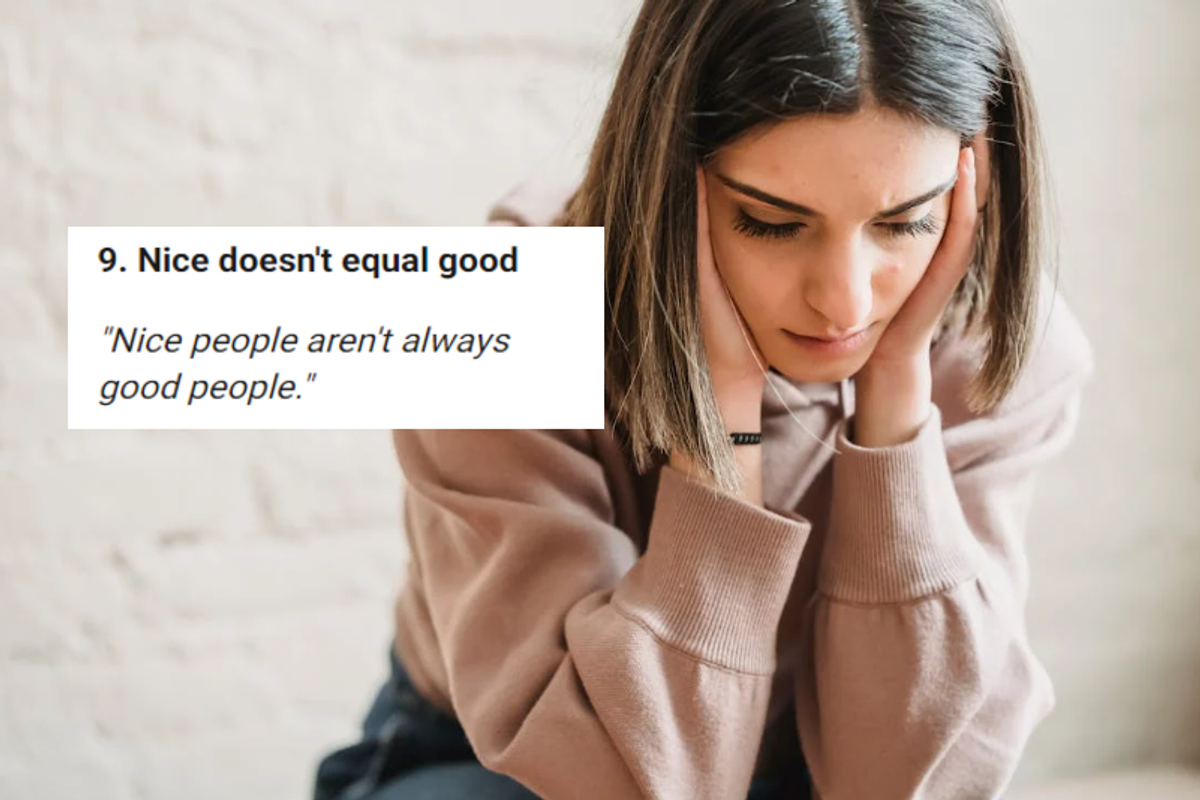A significant part of adulthood is realizing that many uncomfortable truths are indeed real, even if we wish they weren’t. At first, these harsh truths may dampen our spirits and make us feel that the world is a bit colder. However, understanding some of life's hard lessons opens us up to greater possibilities and can help us overcome the obstacles holding us back.
Harsh truths help us realize when relationships aren’t as great as they can be. They also prevent us from having too much faith in people and institutions that will ultimately disappoint us. Knowing dark truths can also help us appreciate the things that are truly beautiful, honest, and good. A Redditor named Rare_Can_5418 asked the AskReddit forum, “What difficult truths, the sooner you accept them, the better your life will be?” and received over 6,500 responses. Many of them were centered around harsh truths about relationships and the fact that even if we do our best in life, we can still end up with the short end of the stick.
The key is to keep going and never let failure get you down.
Here are 15 of the “difficult truths” that made people’s lives a lot better.
1. Stop comparing yourself
"There will always be someone better looking, better educated, younger, more experienced, more intelligent or wealthier than you. Do your best, live without regret, have empathy and kindness, give when you can, expecting nothing in return. Focus on your heart value more than what others have."
"Comparison is the thief of joy."
Research shows we have a tendency to compare ourselves to highly visible and highly skilled people, which makes us feel worse. We wonder why we can't cook as well as our foodie friend or why we're not as organized and put-together as our Type A neighbor. No wonder comparisons make us feel like crap!
 Comparison is the thief of joy. Giphy
Comparison is the thief of joy. Giphy
2. Some people won't like you
"You can be sweetest, juiciest peach on the tree. But some people don't like peaches."
"In Spanish, there's a saying: 'Nadie es moneda de oro para que lo quiera todo el mundo,' which translates to something like nobody is a gold coin to be liked/wanted by everyone else."
Worrying too much about making everyone like you is a quick path to becoming a people pleaser, an impossible task that takes a serious toll on your mental health.
3. Things are just things
"They don’t have feelings. They don’t care if you give them away or sell them or throw them out. If a thing is useful, keep it. If not, get rid of it."
Psychologists refer to perceiving that inanimate objects have feelings as anthropomorphizing. Psych Central says that humans project feelings onto objects to relate to them more deeply. "People generally anthropomorphize to make sense of events and behaviors they experience. Further, attributing emotions, attitudes, mental states, faces, and values to non-human things can help you feel connected to something," Sarah Barkley writes in a PhD-reviewed article.
 Things don't care if you throw them away. Giphy
Things don't care if you throw them away. Giphy
4. Not all friendships last
"Surprisingly though, the ones that last are not necessarily the best (or even good) ones."
"Most friendships are based on convenience, I've found. Unless two people are willing to put in a lot of effort, time and distance will do more to end a friendship than any disagreement."
It's natural and OK to outgrow friendships. If you've put in a solid effort and it's not working the way it used to, being comfortable with letting the relationship go will do wonders for your guilt and stress levels.
5. You may be the bad guy
"You can do your best with someone and still be the villain in their story."
"One of my current favourite memes is: I don't care if I'm the villain in your story, you're the clown in mine."
The truth is we're all just people doing our best, even the people who have wronged you.
 You might be the villain in someone's story. Giphy
You might be the villain in someone's story. Giphy
6. You can't change people
"You can only help people who actually want it. If they’re not ready to change or put in the effort, there’s not much you can do. Realizing this can save you a lot of frustration and help you focus on people who actually appreciate your help."
"It’s always tough having those friends who are constantly complaining but doing nothing to address what they are complaining about. But as an adult, you just have to sit there and listen. No point in offering help to someone who isn’t asking for it. Kinda like how it’s really tough to teach someone who isn’t interested in being taught."
Expecting others to change is bound to lead to disappointment. There's a saying that goes, "When people show you who they are, believe them." Hoping and wishing and working to make them somewhere else, more often than not, gets you nowhere.
7. How we judge ourselves and others
"We judge ourselves by our intentions. We judge others by their actions."
"In psychology, this is called fundamental attribution error."
The Fundamental Attribution Error is a psychological phenomenon where we assume someone's actions reflect their personality without considering the situation. It's like when we blame someone's driving skills for being in an accident instead of the curvy road.
 We judge others differently than how we judge ourselves. Giphy
We judge others differently than how we judge ourselves. Giphy
8. Depending on people
"Once you're an adult, there really isn't anyone you can 100% depend on except yourself. There will still be people in your life to lean on, but everyone has their limits in how they can help you."
Perhaps one of the harshest truths of all, but once you accept it, the path forward becomes extremely clear. It's up to you to make everything happen, and there's really no one else to blame if you don't.
9. Nice doesn't equal good
"Nice people aren't always good people."
"One of my bosses doesn't greet/make small talk and is known for being quite firm. He's been the most helpful throughout my most difficult period dealing with tragedy. Some people with that personality type simply get things done when you need them done without the chattering."
Niceness can even be toxic when it's not coming from a place of genuine authenticity. Sometimes hard conversations and conflict are necessary, and avoiding them is not healthy.
10. Everything is temporary
"You can suddenly lose anything and anyone at any time...and maybe all at once or in quick succession without so much warning."
11. Nobody is thinking about you
"In general, people in the real world are oblivious to you. You're not even a blip on their radar. If you're insecure about something you wear or how you look, remember: nobody cares."
Worried about something small like how the sleeves on your shirt fit you? It's OK if you care, but no one else will. People are far too consumed with their own lives and problems to remember the minutiae of some stranger they saw in passing. Accepting this is incredibly freeing!
 Nobody is paying attention to you (and that's a good thing). Giphy
Nobody is paying attention to you (and that's a good thing). Giphy
12. No one is coming to save you
"No one is coming to save you, so you have to do it all yourself."
"And once you internalize this and do it, your self-esteem will be through the roof."
13. Nobody knows what they're doing
"Before i graduated high school I thought, thank god, I finally won’t have to deal with annoying obnoxious kids and I’ll be treated like an adult, I come to find out 95% of adults are worse then the actual kids, nobody knows what they’re actually doing and life is actually a big joke."
This realization could help cure your Imposter Syndrome. Most people are just making it up as they go along and so you shouldn't feel ashamed of doing the same.
14. Love is reciprocal
"If a romantic interest is not giving you the same attention/respect you give them, they don't really care about or want you, and you're in for a world of hurt if you keep telling yourself otherwise."
 We accept the love we think we deserve. Giphy
We accept the love we think we deserve. Giphy
15. Who's good for you?
"People who are good for you will make you feel happy, joyful, accepted, cared for, and filled with fun times, despite any differences. People who are not good for you will make you feel anxious, sad, down, slighted, judged, and never check in on you if you're not okay, and won't even bother noticing when you're not okay. Genuine people will never let you suffer in silence or watch you suffer. Stay away from those who make you feel negative emotions and thoughts."
These are called harsh or hard truths for a reason. It's human nature to feel self-conscious, feel like an imposter, try to change people, or worry if other people like us. But the more of these you can free yourself from, the better you'll feel.
This article originally appeared last year. It has been updated.









 Comparison is the thief of joy.
Comparison is the thief of joy.  Things don't care if you throw them away.
Things don't care if you throw them away.  You might be the villain in someone's story.
You might be the villain in someone's story.  We judge others differently than how we judge ourselves.
We judge others differently than how we judge ourselves.  Nobody is paying attention to you (and that's a good thing).
Nobody is paying attention to you (and that's a good thing).  We accept the love we think we deserve.
We accept the love we think we deserve. 
 Screenshot of Jamie Lee Curtis and Michelle Yeoh at the 2023 Golden Globes
Screenshot of Jamie Lee Curtis and Michelle Yeoh at the 2023 Golden Globes  Jamie Lee Curtis at the 41st Emmy Awards in 2006
Jamie Lee Curtis at the 41st Emmy Awards in 2006 Gif of Jamie Lee Curtis clapping via
Gif of Jamie Lee Curtis clapping via 

 The changing room brought out a painful revelation.
The changing room brought out a painful revelation. 
 A woman appears stressed while working on laptop. Photo by
A woman appears stressed while working on laptop. Photo by